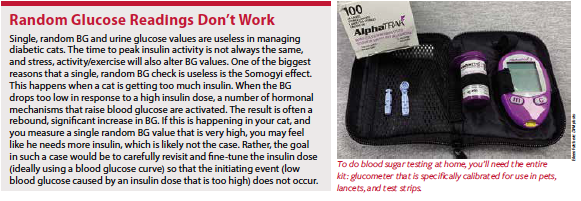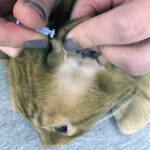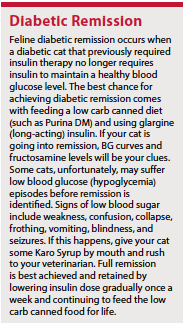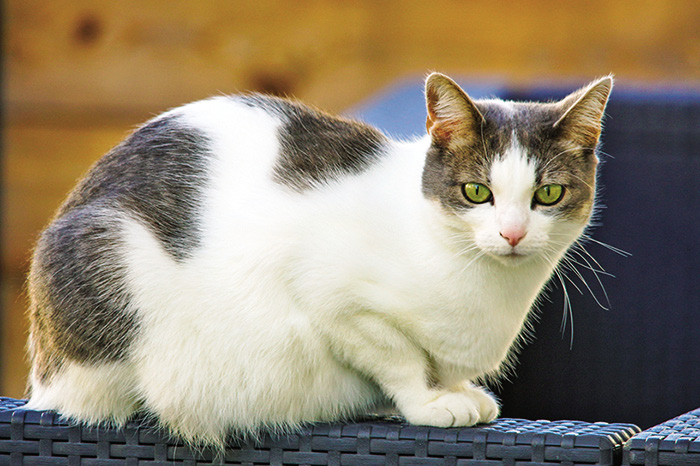Just as in humans, feline diabetes is a chronic disease in which the body cannot properly produce or respond to the hormone insulin. This results in elevated levels of the sugar glucose in the blood, which is the main source of energy for the body. Uncontrolled, high blood sugar will damage the cat’s body, eventually resulting in coma and death.
Diabetes is not uncommon in cats, especially overweight cats. It’s an upsetting diagnosis for cat owners who worry they won’t be able to manage it. They worry about cost, and they worry about giving shots. In the spirit of putting some of those fears to rest, if you’re lucky and your cat’s sugar gets under control easily, the cost may not be as scary as you think. And, once you learn how, a shot is a heck of a lot easier to give a cat than a pill.
You will incur some expenses when your cat is diagnosed with diabetes. A diagnostic workup is necessary to check for other possible diseases often seen in diabetic cats, including kidney disease, pancreatitis, dental disease, and urinary tract infection. These problems may make diabetic regulation trickier, so they’re important for your veterinarian to identify.
You will need to purchase insulin and syringes. Prescription low-carb food is frequently prescribed as well, and it is usually pricier than a bag of food at the grocery store. Finally, your cat will need frequent (usually weekly) blood sugar monitoring, at least in the beginning, until a maintenance dose of insulin has been determined. This is sometimes your greatest expense, depending on how easy it is to achieve good glycemic (blood glucose) control.
Blood sugar monitoring for diabetes is ideally done with what’s called a blood glucose (BG) curve. BG is checked either every two to four hours, depending on what type of insulin you’re using, for 12 hours in a row. This allows your veterinarian to see how low the glucose gets with a certain dose of insulin and how long the dose keeps the glucose down. With this information in hand, dosage adjustments can be made. A new BG curve is usually recommended one week after a dosage change.
BG curves are typically done in the veterinary clinic. A day stay is required, which usually includes a hospitalization charge, multiple blood draws/glucose tests, and professional fees for your doctor and licensed veterinary technician. This can get pricey quickly and can be stressful for your cat.
An alternative is to do your BG curves at home, if you have the time, dedication, and your veterinarian is on board with the idea. If your cat requires multiple dosage changes and weekly recheck curves, at-home BG checks can save a lot of money in the long run. They also eliminate the stress of hospital stays for your cat. This is important, as stress can increase blood glucose significantly in cats, making interpretation of in-hospital glucose tests more challenging in some cases. Since you will send the results of your at-home BG testing to your veterinarian for interpretation, there may be a nominal fee for this.
You will have to invest in a glucometer and test strips. These are readily available at medical supply stores and online. Not all glucometers are created equal, however, and some are better than others, especially when it comes to use for pets. The Alpha Trak 2 by Zoetis, specifically calibrated for cats and dogs, is generally the most popular, but talk to your veterinarian for advice. You could also consider having a blood glucose test done at your veterinarian’s to compare with a simultaneous sample from your glucometer to check for glucometer accuracy.

The BG Curve
It’s important to recognize what the medical goals are in diabetic management. Achieving a perfectly normal BG every minute of every day is not the goal. The main goals in diabetic management are:
- avoid low blood sugar events
- maintain a healthy weight and appetite
- minimize excessive thirst and urination
- prevent prolonged high blood sugar episodes
The best ways to achieve these goals are to feed the recommended low-carb diet twice daily on a regular schedule, give the recommended dose of insulin twice daily on a regular schedule, minimize stress, and follow your veterinarian’s advice regarding BG curves and your cat.

Once your cat is on a steady dose of insulin, life usually gets easier. You can simply monitor your cat’s attitude, appetite, water consumption, urine production, and body weight to assess how things are going. At this point, there is usually no need for blood sugar curves unless any of these things change.
Alternative Approaches
You may have wondered about the heavily advertised Freestyle Libre flash glucose monitoring system for humans. This device can be used for BG monitoring in dogs and cats. It is applied by your veterinarian and is usually placed on the hip area in cats. The challenge, especially with cats, is securing the device to the skin, and having the pet leave it alone (you may need to experiment with shirts for the cat and/or Elizabethan collars). The sensor works for 14 days, so you’ll need to purchase a new one when the insulin dose is adjusted and a BG curve is usually recommended.
monitoring system for humans. This device can be used for BG monitoring in dogs and cats. It is applied by your veterinarian and is usually placed on the hip area in cats. The challenge, especially with cats, is securing the device to the skin, and having the pet leave it alone (you may need to experiment with shirts for the cat and/or Elizabethan collars). The sensor works for 14 days, so you’ll need to purchase a new one when the insulin dose is adjusted and a BG curve is usually recommended.
You can use an iPhone app with the Freestyle Libre system. You just hold your phone up to the monitor attached to your cat to obtain a glucose reading. The kit also comes with a reader, so don’t despair if you don’t have an iPhone. This device measures glucose in the interstitial fluid (fluid outside the blood vessels), so the values lag a little behind the actual BG, but that’s OK, provided you consistently use this system to monitor and compare blood glucose over time. The Guardian RT Real Time Continuous Glucose Monitor is a similar system that was developed for pets.
Another useful tool for monitoring BG in diabetic cats is the fructosamine blood test (fructosamine is a compound in the blood that is a combination of glucose and protein).
While the BG curve is like a fine-tuning tool, the fructosamine level is more coarse tuning. This blood test, done by your veterinarian, tells you approximately where the BGs have been over the past month. If the level is nice and normal, there’s no need for a stressful BG curve. If the fructosamine is high, your veterinarian will likely recommend a BG curve. If it’s low, there’s a good chance your cat is going into diabetic remission.
If your cat is diagnosed with diabetes, this information should help you understand the finer points of diabetic management, so you can feel more confident treating and caring for your sweet (pun intended) furry friend. It will help you get your cat regulated as quickly as possible—maybe even achieve remission (at which time insulin therapy can be discontinued). Diabetic remission is a good, reasonable, achievable goal, and it’s awesome when it happens.



